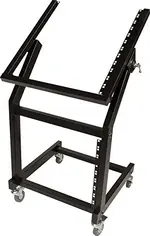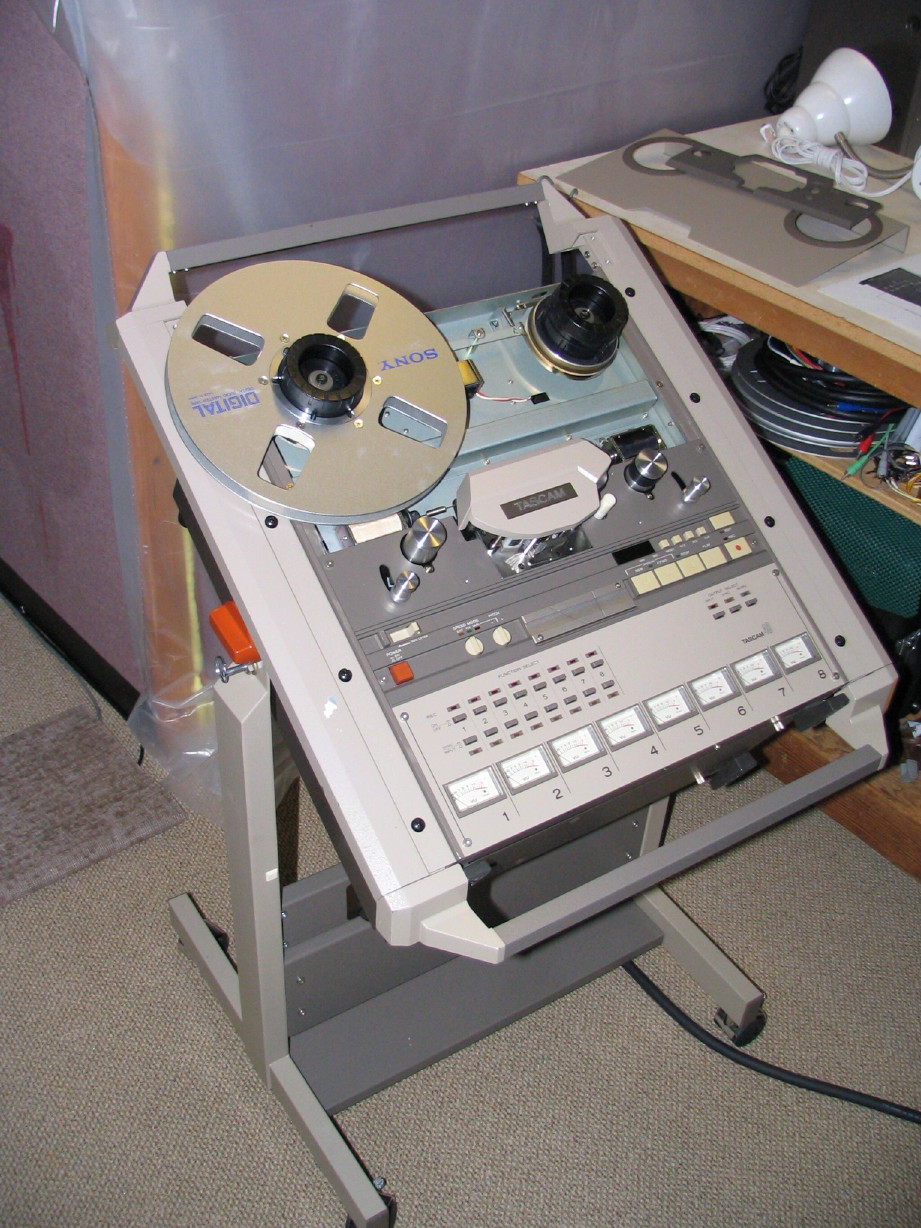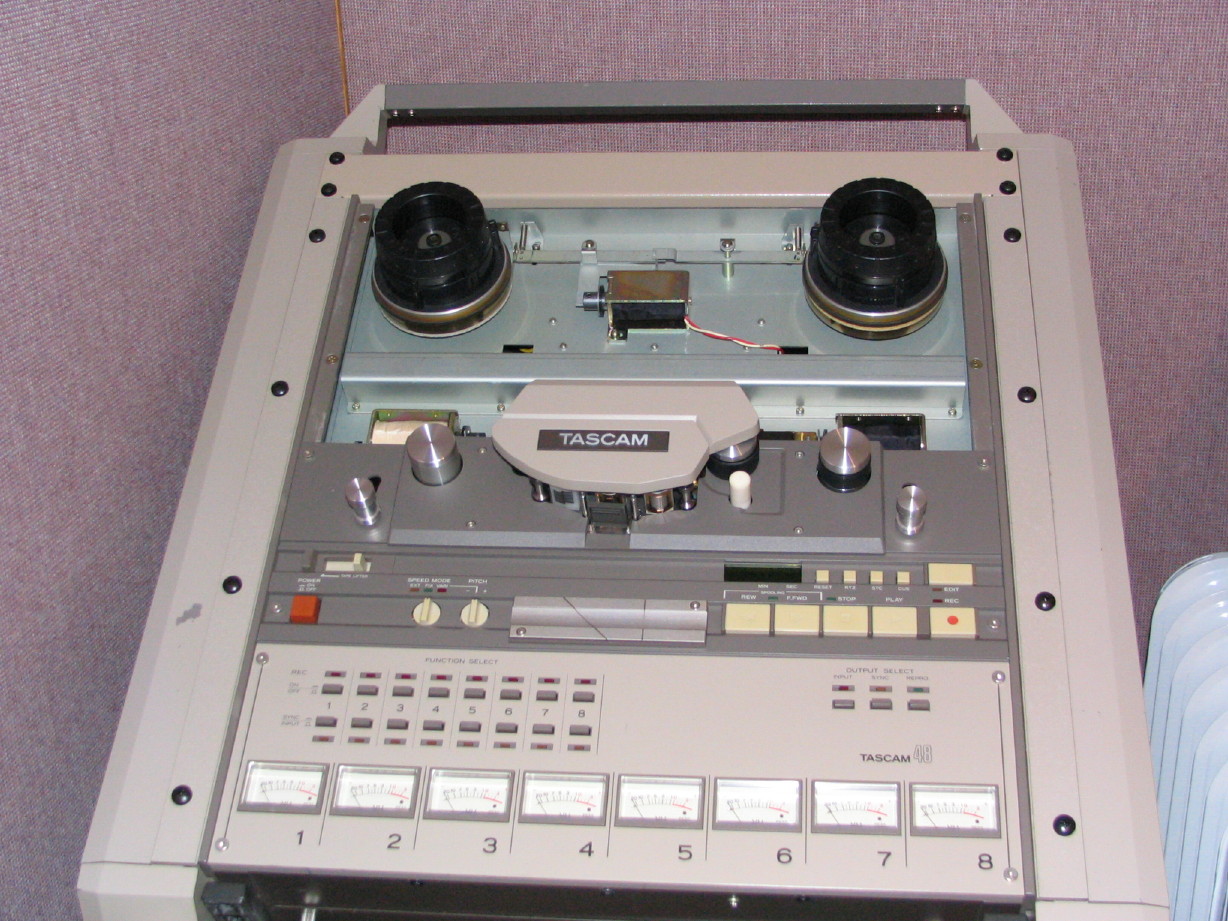Did a number of things last night.
My reel table on the left side is not flat...the rubber is higher on one side of the table than the other so the tape reel height fluctuates, which doesn't work when you are using precision reels because there is a lot less wiggle room flange to flange. I tried all of my spare tables (2 spares from the parts deck), and they all have this problem. I put the one that was the best on the deck. It was good enough, but I may order a new one at some point or find some other way to true them up.
Got out the super-bright LED flashlight, magnifying glass and screwdriver to do some fine adjusting on the tape path. I must say, that as long as the tension arms are straight, the 48 is a dream to adjust the tape path. The procedure in the manual is important to read because it includes some fine points that you wouldn't normally think to do and are critical to the process. Another advert to have/read/know the manual for your equipment...respect the deck.
The first thing you are supposed to is to pull the top cap off the left tape guide, and then adjust the left tension arm height so the tape just touches the base of the guide. I wouldn't think to pull the cap off. Then you set the right tension arm height so that the tape rides in the middle of the counter roller. Mind you that, because I'm using 6-screw precision reels on both sides, fairly minor adjustments in the tension arm height requires some adjustment in the reel-table height so I was kinda going back and forth on that. Now here's the trick...after I did the procedure in the manual (and it is difficult to determine if the tape is riding on the center of the counter roller...I was able to get the best view looking up from underneath at the bottom of the counter roller), the tape was still a little squirrely in the impedance roller and even on the counter roller when shuttling between FFWD and REW and REW and PLAY. The manual states to keep adjusting the right tension arm height if the "tape movement is inconsistent" during FFWD or REW modes; to adjust the right tension arm height until there is no fluctuation in movement. I didn't quite understand how to apply this information at first because, contextually, the test in the manual is referring to the tape behavior at the counter roller, but I was dealing with some of this behavior on the impedance roller as well and thinking I couldn't touch that now that the left side tension arm was set to the left guide. Well, here's how I ended up fine-adjusting my tape path (and remember to keep the reel table heights adjusted as you go if necessary in order to keep tape from rubbing on any reel flanges, and make sure your tension arms are square to the dress panel when checked side-to-side and up and down):
- Load yer tape and shuttle the transport to get about the same amount of tape on each reel.
- Execute the procedure in the manual, page 7-18 section 'B' "Tape Path", and reinstall the left tape guide cap.
- Shuttle back and forth between FFWD and REW (like, you don't need to let it spool up to speed...lettin' it go in REW for about 3 seconds maybe, and then hit FFWD, 3 seconds hit REW, etc...) and watch the tape on the impedance roller...is it sitting still (no fluctuation in tape height from the top to the bottom of the roller)? If it is sitting still, apply the procedure below to the counter roller and right tension arm (basically, skip to step 9 which applies the procedure written in steps 3 ~ 8). If it is not sitting still (if the tape height is fluctuating), put yer tweaker on the left tension arm height adjustment screw found just beneath the impedance roller and...
- Turn the screw a 1/4 turn either counter-clockwise or clockwise (I haven't gone to the trouble to try and figure out which direction does what relative to the behavior of the tape, so just turn the screw already, huh?).
- Tape behavior better? Worse? Can't tell?
- If it is better, but not quite there yet, turn the screw another 1/4 turn in the same direction.
- If it is worse, turn the screw 1/2 turn in the opposite direction
- If you can't tell, keep going in 1/4 turn increments in the same direction until you can tell what effect your tweaking is having.
- Keep doing the above steps until you can't tell if the tape height is fluctuating on the impedance roller, and keep in mind that when you do make adjustments to the tension arms, it is a good idea to shuttle the transport back and forth enough to get a few full wraps of tape on each reel at the new height adjustment so that when you check to see how the tape is behaving with the new tension arm position, the tape entering the tape path is consistent with the new tension arm position.
- Once the tape is sitting still on the impedance roller height-wise when shuttling the transport, move over to the right side and do the same thing but relative to the right tension arm and the counter roller
- Once the tape is sitting still height-wise when shuttling the transport on the counter-roller, go back and check to make sure the tape is still sitting still on the impedance roller...if it isn't, do the procedure again to get it sitting right (the tension arm height should be pretty close now though).
- Didja have to tweaker in the last step? If so, go back and double-check the tape behavior on the counter roller and adjust the tension arm height to stop the fluctuation.
- Keep going back and forth between the two rollers working the adjustments while shuttling the transport until the tape sits still on both rollers.
- Now, try going from REW to PLAY...it should look good on both rollers.
- Do the transport shuttle thingy (FFWD to REW, REW to PLAY and so on) and look at the tape behavior in the tape guides. It should also look good, like if you couldn't see the tape traveling you would have no idea that the tape is moving at all.
- Now pull the cap off the left tape guide, getcher bright flashlight and magnifying glass (we're going to double-check that the tape is just touching the bottom of the tape guide...it should be). Turn the adjustment screw for the left tension arm in 1/4-turn increments counter-clockwise. You should see the tape ride up off the bottom of the left tape guide within 1/4 ~ 1/2 a turn IMO.
- Assuming all looks good, put the left tension arm height adjustment screw back where it was at the beginning of the last step by turning it clockwise the same amount you turned it counter-clockwise.
- Reinstall the left tape guide cap.
- One last survey...tape height still doesn't fluctuate on either the impedance or counter rollers when shuttling from FFWD to REW and REW to PLAY? Does the tape also still sit still/look good in the tape guides when shuttling? No tape rubbing on reels?
- If yer like me, now you're going to do step 19 with the tape at the beginning and the end of the reel.

Okay. If your transport and tape path pass muster on the above procedure, your tape packs should look wonderful, and your transport should be quiet and smooth. PHEW! 
It seems like a lot, but really, once you get the rhythm of the shuttling and looking back and forth between the rollers and moving the tweaker as you go (pausing the rhythm to adjust those reel tables of course), it really doesn't take that long. With the procedure now under my belt I suppose it might take me 10 minutes...it got faster as I went.
PLEASE PM ME IF ANY OF THE ABOVE INSTRUCTIONS ARE CONFUSING OR YOU HAVE SOMETHING TO ADD TO THEM AND I WILL EDIT THE POST
Comparing the 48 and the 58, the 58 kind of does itself in with the 3 tape guides and frankly that's what makes it so much more complicated because on the 58 the tape is supposed to touch the bottom of guides 1 and 3, and the top of guide 2. What this means is that the guides are
wider than the tape, and rather than having two fixed points that are the same as tape width (ala 48), you have the 3 points and the wider path which leaves the possibility of the tape being cockeyed slightly in the path...when you juxtapose that with the fact that the tension arms are above and inboard of the guides on the 58 (i.e. the tape wraps about 150 degrees or so around the counter roller and the pinch roller...no impedance roller), adjustments in the tension arm height take longer to realize visually in the tape path...its easier to be like a dog chasing its own tail.
Now, the interesting thing is that when I loaded tape last night and put the deck into EDIT the reels started crawling.  So I also double-checked the tension sensor voltages (the left was off by about 0.2VDC...no big deal but I adjusted it anyway), and the right arm was a little low in repro so I tweakered that. Then when I went to re-check the tensions the takeup side was just out of spec (too high)...I'm chalking it up to fuzz or dust in the sensor or the deck just waking up these past few days after years of rest...not worried about it. It being too high does indeed explain the crawling. I adjusted it back down end everything is working just great. This is the payoff, guys. It took me maybe 10 minutes to do all the above stuff relaitve to the crawling issue, including removing covers to access test points and spring adjustments and such. This is not to boast. I'm just pleased that the struggles and learning over the past couple years has paid off in this way, and again it is almost entirely a credit to this forum as well as some gracious souls over at the Tascam Analog Only forum who are also active here (hilltop studios and pianodano). If you are new to the forum and are reading this, check out my "Tascam 58-OB Story..." for an prime example of the kind of support, helps and community that can be found here...some amazing analog-o-philes in that thread...read it to see who they are. Whether it be real technical support and teaching, just plain fun jawing and sharing, or a kind word of encouragment when you make a really big mistake, I think this is a realatively rare online community.
So I also double-checked the tension sensor voltages (the left was off by about 0.2VDC...no big deal but I adjusted it anyway), and the right arm was a little low in repro so I tweakered that. Then when I went to re-check the tensions the takeup side was just out of spec (too high)...I'm chalking it up to fuzz or dust in the sensor or the deck just waking up these past few days after years of rest...not worried about it. It being too high does indeed explain the crawling. I adjusted it back down end everything is working just great. This is the payoff, guys. It took me maybe 10 minutes to do all the above stuff relaitve to the crawling issue, including removing covers to access test points and spring adjustments and such. This is not to boast. I'm just pleased that the struggles and learning over the past couple years has paid off in this way, and again it is almost entirely a credit to this forum as well as some gracious souls over at the Tascam Analog Only forum who are also active here (hilltop studios and pianodano). If you are new to the forum and are reading this, check out my "Tascam 58-OB Story..." for an prime example of the kind of support, helps and community that can be found here...some amazing analog-o-philes in that thread...read it to see who they are. Whether it be real technical support and teaching, just plain fun jawing and sharing, or a kind word of encouragment when you make a really big mistake, I think this is a realatively rare online community.
Anyway, 'nuf touchy-feely...

Since I replaced the left reel table and adjusted both table heights I wanted to double check the brake tensions so I did that. They were pretty much "there", but the left side was a little low.
I reinstalled all the panels except for the top dress panel...come to think of it I'm not sure why I left that off at this point. It was late.

Since the next steps involve audio (i.e. head contact, azimuth, and then electronics calibration), it was time to move the 48 into the control room which meant the 58 had to move out.

Sort of symbolic. I do still intend to get it going...it still has its place
for sure, but things are going so well with the 48 at this point and I'm hopeful, again, that it can be ready to be used on my current project, so I'm prioritizing.
I moved the ES-50 syncronizer to the 48 rack, and I'm cleaning up/checking out the two DX-4D's I've acquired (anybody need any dbx 150X's???) that will join it...I'm still waiting to receive some cabling I've purchased through a number of sources...I've decided to buy pre-made snakes instead of building them. Too much time at this point to build all the cables and there would be a lot of them since I'm using the DX-4D's and interfacing the 48
and M-520 with patch bays.

But the 48 is now sitting next to the M-520 in control room looking eager to get calibrated and start capturing sounds. I started running snakes last night to get the M-520 connected to the studio snake and the digital rig. More on that in my "
Tascam M-520 Story..." thread.
It'll be a few days before I continue on the 48, but my hope is that the electronics calibration goes like the rest of the process has gone so far. I know the amp card for track 7 doesn't pass audio, at least that's the way it was about a year ago when I last checked so we'll see. But, again, thanks to this community, I'm not the least bit concerned about that hurdle. I'll deal with it when I get there, and it shall succumb.

The 48 wants to work.
OH! Another comment on the CS-607...If you do your own maintenance and calibration,
don't get a cheapy rack like this:

Folks, it is just not worth it. Whether you access your cal trimmers from the front or bottom or whatever, at some point you're going to need to access stuff in the back and it is a significant pain to try and do work at the back of the deck with it tilted back toward you at 45 degrees. Tascam did a
great job on the design of the CS-607 rack. Its sits lower and is narrower than the rack pictured above, is
much sturdier and better built and easier to adjust...during my activities last night it was such a treat to be able to easily lay the deck flat, set it upright, set my tensions with the deck at 30 degrees...I can't say enough about it after all the work on the 58 in one of those cheap stands. Yes you do loose 7U of rack space down below...it isn't worth it...get another rack for that stuff if you need it. So if you've got a tabletop style recorder-reproducer, think about it. If I knew what I know now, I'd have willingly paid $200 for a CS-607. I paid $100 for mine (missing the stopper/locking pin assemblies and casters) and it was worth every penny.







 ). He was over sharing his latest and I convinced him to come out to the "studio". It was tracked digitally, but even with careful application of my gear and the mastering process I can still hear the converters squaring off the edge of his vocal chords...hard to explain but I've experimented with this and it is one of those digitalisms that jumps out to my ears and it is not the conversion to the 128kbit mp3
). He was over sharing his latest and I convinced him to come out to the "studio". It was tracked digitally, but even with careful application of my gear and the mastering process I can still hear the converters squaring off the edge of his vocal chords...hard to explain but I've experimented with this and it is one of those digitalisms that jumps out to my ears and it is not the conversion to the 128kbit mp3 

 either...I can hear it on the 24bit 88.2kHz raw tracks as well...my analog experiments totally avoid this and I can't wait to capture audio to analog in the future.
either...I can hear it on the 24bit 88.2kHz raw tracks as well...my analog experiments totally avoid this and I can't wait to capture audio to analog in the future.



